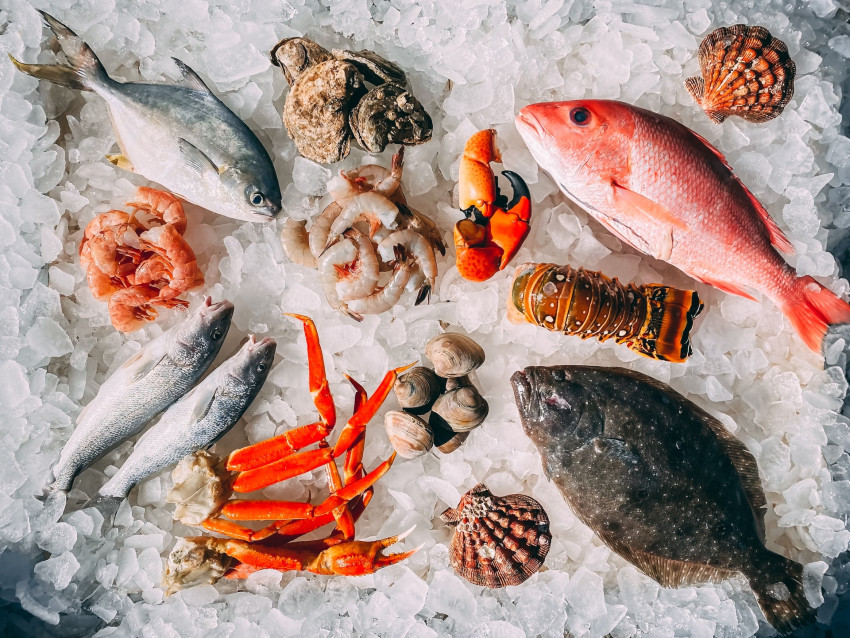
Freezing fresh seafood products is a common preservation method used by fish processing companies and exporters like the best yellowfin tuna exporters in the world, It helps maintain their quality and safety and extends their shelf life. Freezing these food types rapidly at low temperatures can prevent the growth of microorganisms and slow down enzymatic reactions, which would otherwise lead to spoilage. Freezing also helps retain the flavour, texture, and nutritional value of the seafood.
Here are some reasons why fresh seafood products should be frozen, according to the best swordfish suppliers in the region:
- Preservation: Freezing inhibits the growth of bacteria, yeasts, and moulds, which are responsible for spoilage. This helps preserve the seafood's freshness and quality for a longer time.
- Safety: Freezing at sufficiently low temperatures can kill or deactivate harmful pathogens that might be present in the seafood, making it safer to consume.
- Seasonal Availability: It allows the food to be stored and made available throughout the year, even when the seafood is not in season or available in local markets.
- Convenience: It offers convenience for consumers, as it can be stored for longer periods without the need for immediate consumption.
Methods used to freeze seafood:
- Blast Freezing: This is a rapid freezing process that exposes it to very low temperatures in a short amount of time. It helps to minimize ice crystal formation, which can damage the cellular structure of the seafood. Blast freezing is commonly used for large quantities of seafood in industrial settings.
- Plate Freezing: This involves placing it between two cold plates or metal surfaces, where it is frozen quickly and uniformly. This method is often used for flat or thin seafood items like fillets.
- Individually Quick Freezing (IQF): IQF is a method where individual pieces are frozen separately rather than in bulk. This process prevents the pieces from sticking together, allowing consumers to take out only the amount they need without thawing the entire package.
- Cryogenic Freezing: This involves using substances like liquid nitrogen or carbon dioxide to rapidly freeze seafood. This method is particularly suitable for delicate or high-value products, as it can preserve their quality effectively.
- Air Freezing: This is a simple method where seafood is placed in a freezer and exposed to cold air until it is frozen. This method is commonly used in households and small-scale operations.
It is essential to freeze seafood properly and at the right temperature to ensure its safety and quality. Once thawed, frozen seafood should be handled and cooked following proper food safety guidelines.
Some tips on freezing fresh seafood
Here are some tips on how to freeze fresh seafood properly to maintain its quality and safety:
- Start with Fresh Seafood: The key to high-quality frozen seafood is to start with fresh, high-quality seafood. Purchase it from reputable sources and ensure it is fresh before freezing.
- Clean and Prepare: Before freezing, clean it thoroughly and remove any dirt, debris, or unwanted parts. For fish, remove scales and guts, and for shellfish, remove the shells and clean the meat.
- Chill Quickly: For best results, chill it quickly before freezing. Place it in a bowl of ice water or in the refrigerator for a short period to reduce its temperature. Avoid leaving it at room temperature for too long before freezing.
- Portion Properly: Divide it into smaller, individual portions before freezing. This will make it easier to thaw only what you need later, preventing unnecessary waste.
- Use Airtight Containers: Use airtight containers or freezer bags designed for freezing to store the seafood. Removing excess air from the containers will help prevent freezer burn and maintain its quality.
- Label and Date: Always label each container or bag with the type of seafood and the date it was frozen. This will help you keep track of the storage time and easily identify the contents later.
- Minimize Freezer Burn: To minimize freezer burn, ensure there is minimal air inside the packaging and tightly seal the containers or bags. Freezer burn can negatively affect the texture and flavour of the meat.
- Freeze Quickly: For optimal results, freeze the seafood as quickly as possible after cleaning and packaging. Quick freezing helps to retain its quality by minimizing the formation of large ice crystals.
- Use the Right Temperature: Set your freezer to a temperature of -18°C (0°F) or lower to ensure it freezes quickly and stays safe for an extended period.
- Avoid Refreezing: Once you thaw it, it is best not to refreeze it. Refreezing can lead to a loss of quality and potentially pose food safety risks.
- Keep an Eye on Storage Time: While frozen food can last for several months, it is best to use it within three to six months for optimal quality. Keep track of the storage time to avoid consuming seafood that has been frozen for too long.
By following these tips, you can ensure that your frozen seafood remains safe, tasty, and enjoyable when you decide to use it in your recipes.



